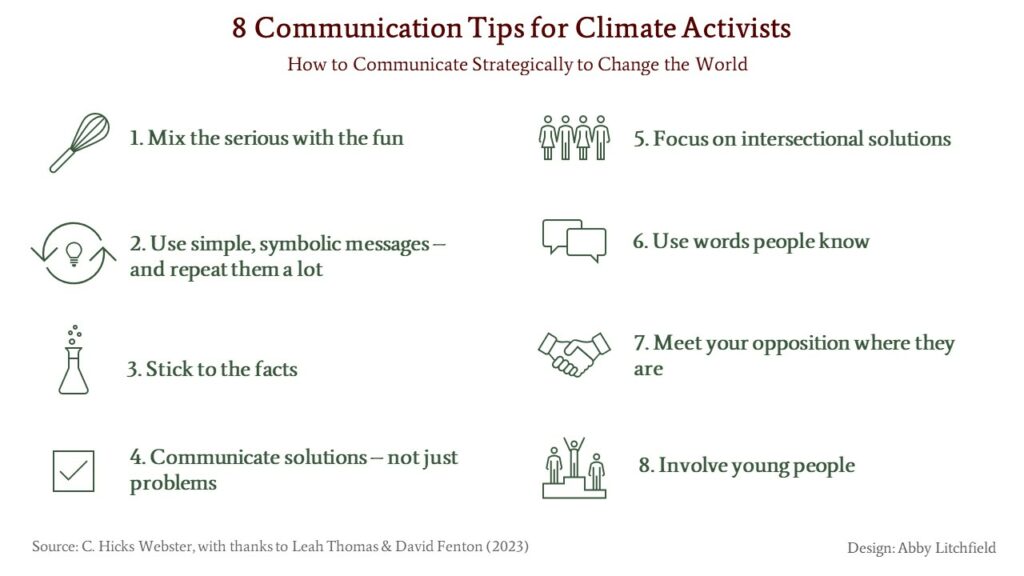Communication is key for activist impact. Here’s how to be heard on the causes you care about.
Are you an environmental activist?
The dictionary defines an activist as anyone who “uses strong actions to support a controversial issue.” That can include group activities, like attending public rallies or coordinating local environmental projects. It can also include changes in your personal lifestyle, like going vegetarian.
If you fall anywhere on that spectrum, you’ll have more impact if you talk about your cause in a way that motivates others. But communication on controversial issues can be challenging.
That’s why the Network for Business Sustainability and Climate Now partnered to create a podcast called How to Talk About Climate Change.
We spoke with three experts who understand how people make decisions about climate change and other environmental issues.
- Professor Elke Weber, a psychologist at Princeton University, studies the decision-making processes that shape people’s responses to environmental change and policy.
- David Fenton, founder of Fenton Communications, has been an activist for over 50 years. He’s an expert in using public relations, social media, and advertising techniques to advance social change.
- Leah Thomas, founder of Intersectional Environmentalist, uses writing and creativity to advocate for the relationship between social justice and environmentalism.
Climate Now synthesized these interviews into a single podcast called “How to Talk about Climate Change” (click here to listen).
NBS is going deeper by writing articles that highlight two key interview themes.
In this article, Leah Thomas and David Fenton offer communication advice for activists seeking to motivate large-scale change. Our sister article offers Elke Weber’s advice for motivating climate action at work.
Communications Advice for Environmental Activists
Whether you’re pushing your workplace to reduce waste, canvassing for a green political party, or running a vegan cooking blog, communication is critical. What you say and how you say it determines whether you’ll convert people to your cause.
Thomas and Fenton offer tips to help your communication make its mark.

Mix the Serious with the Fun
Through her non-profit, Thomas runs a series of climate concerts called Earth Sessions. These events bring together local environmental non-profits and artist-activists to share inspiring music, environmental education, and local solutions.
It’s what Thomas calls ‘mixing the broccoli with the ice cream.’
“The broccoli is the environmental justice education, and the ice cream is having really fun artists. We always partner with local environmental justice organizations and artists who are passionate about the planet. Then we bring people together in one room, sometimes under a tree, for an educational art experience.”
Thomas believes the ice cream gives attendees extra motivation to come out, and the broccoli helps spread important social change messages.
Use Simple, Symbolic Messages – and Repeat Them A Lot
Fenton believes that most activists are making a critical mistake in their communications. They value new ideas and nuance over simplicity and repetition. But it’s the simplicity and repetition that actually change public mindset.
“People who study the humanities, law, and sciences are taught the false belief that a great idea will magically sell itself. We love complexity. We hate simplifying things. We think it’s manipulative and misleading and we hate repeating ourselves. But the brain only absorbs information when the messages are simple and when they’re repeated incessantly.”
If activists want to create large-scale change, they should repeat the same, simple message over and over, until they’re sick of hearing it.
Here’s an example of the power of simple messaging.
In the 1980s, a chemical called Alar was being used to ripen apples in the United States. Research showed that Alar was causing cancer, but the US government was reluctant to ban its use.
The US non-profit Natural Resources Defense Council hired Fenton to rally public support. Fenton describes how he kept the message short but powerful.
“We decided to focus on the symbolism of poison apples. An apple a day is supposed to keep the doctor away, not make your kid sick.
One night we got on the TV show 60 Minutes, back when 35 million people watched it, to do a segment on this. They started the segment with a picture of an apple with a skull and cross bones, and showed that the government knew this was a dangerous chemical, but wasn’t doing anything about it.
The next morning, the country stopped buying apples. Within five days, the manufacturer was forced to withdraw Alar from the market in order to restore the apple market.”
The takeaway? Keep your message simple and symbolic, and say the same thing to as many people as possible.
Stick to the Facts
Simple messaging should not dilute the facts. Fenton and his partners based their messaging on peer-reviewed science; when the apple industry sued for libel, it lost.
Thomas also emphasizes the importance of an evidence base for activist work. The digital world makes it tempting to “trade truth for click bait.” Activists shouldn’t give in.
“Gen Z’ers are getting their news from TikTok more than any other platform, which to me is scary. There’s not a lot of legislation on misinformation and disinformation. I’d encourage people to cite their sources, just like you would in a research paper.”
Communicate Solutions – Not Just Problems
Sharing solutions helps create motivation that moves people to action, says Thomas. That’s partly because solutions provide hope. That can be valuable in overcoming a sense of overwhelm.
“Climate doom messaging has been used to compel people to act. We’ve had a humongous amount of climate organizing, but unfortunately it has also led to an extreme amount of climate fatalism. That leads to apathy and inaction, because if you feel like there’s no hope for the future, why are you going to act? What’s really worked for me is showing people that there is hope.”
Thomas suggests that activists profile local solutions. That way, those listening see a direct pathway for action in their own community.
Focus on Intersectional Solutions
Any action toward environmental preservation can be positive. But some actions create deeper impact than others.
Thomas sees intersectional solutions as being uniquely high impact. That means simultaneously addressing environmental issues (like climate change) and social justice issues. Social justice means that all people have equal political, economic, and social rights.
Here’s an example: Race and income are two identities that predict which communities have adequate tree cover (and clean air and drinking water) – poor, black communities often lack these basic necessities. Planting trees in poor neighbourhoods helps stop climate change and reduces inequity in green space availability.
Is there a Black-led environmental organization in your town? If so, consider profiling the work of that organization, over the work of a White-led organization. This advances environmental goals while also addressing historical inequity in who has voice and power.
Highlighting intersectional solutions helps channel support to the highest impact causes.
Use Words People Know
Every professional culture speaks its own ‘language.’ That matters. Your message sticks in people’s minds when you use the words they use, says Fenton.
“As you’re exposed to language and imagery over your lifetime, it forms literal circuitry in your brain. These are called frames. Successful communication activates existing frames. But we have a big problem in the [environmental] world. Much of our language is unclear to the public.”
Think about the language you use and test it out – even on your family and friends. If your friends can’t understand it, others may not either.
What if testing reveals that people are confused? You can swap in wording they’re more familiar with. Or, you can provide definitions of new terms.
Meet Your Opposition Where They Are
Change requires reaching people who don’t currently support your cause. You need to show them how your issue connects to their concerns. For example, Fenton has used paid social media ads to show conservatives how climate change impacts conservative values.
“I have bought into the social media feeds of conservatives with videos that feature conservatives talking to conservatives about how climate change threatens conservative values like health, property, refugee flow, and national security. We’ve proven in peer-reviewed articles that their support for climate action grows a lot.”
Involve Young People
Young people are called “digital natives” for a reason. They can bring digital skills to environmental communications. Thomas and other young digital influencers have supported the US government on environmental messaging. When the Inflation Reduction Act was passed, President Biden’s staff invited the young influencers to educate their online communities. Thomas describes the value of this approach:
“Some TikTok or Instagram creators are 19 years old and getting three times more views and engagement on their [climate change] posts than the White House is getting. It’s kind of cute watching the White House trying to navigate TikTok and Instagram. I’ll never forget being in a room with President Biden and his staff saying, ‘Take out your phones, it’s okay!’ They want people to understand this legislation. And it’s working because we’re seeing a lot of Gen Zers wanting to engage in policy in ways that they hadn’t before.”
Communicate Strategically to Save the World
To live within planetary boundaries, human systems need radical change. Fenton and Thomas are committed to creating large-scale change – the kind that unites huge numbers of people and changes political systems. That requires changing our collective thinking.
Communications strategies are a critical part of this. Public communication deserves significant resources. And those communications efforts should follow evidence-based practices – even if those practices push us outside our comfort zone.
Only then can activists create the ripples of change this world needs.
Learn More about the Activists’ Lives
Activists have interesting life stories that inform their work. Let’s explore Leah Thomas and David Fenton’s backgrounds.
Leah Thomas Builds Diversity into Environmentalism
Thomas runs a non-profit, the Intersectional Environmentalist, that helps people understand the connections between social justice and environmentalism. She has been wildly successful in her work, recognized by major lists like TIME100 NEXT, INSIDER’s Climate Action 30, and EBONY Power 100. Her non-profit has more than 400,000 followers.
Thomas’s journey began with an undergraduate degree in environmental science and religion, where she saw how religious texts consider care of the Earth. This got her thinking about the connection between culture and environment.
Her awareness of intersectionality deepened when she interned as a park ranger. She spoke with farmers who were concerned about pesticides but saw their financial benefits. These farmers felt disconnected from agricultural legislation and wanted a voice. Thomas realized this was an example of how inclusivity could improve environmental outcomes.
To document her experiences, Thomas started a personal blog called Green Girl Leah in 2016. In 2020, amidst major racial reckoning in the United States, she used her channel to call the environmental community to action on racial justice. Her message went viral.
“I did a definition of what intersectional environmentalism means and why racial justice is important. I said if you’d like to join me, here’s a pledge I created and action steps to get involved. That post was shared over a million times.”
Thomas began receiving more questions about intersectional environmentalism than she could handle alone, so she founded a non-profit – Intersectional Environmentalist.
David Fenton Uses Evidence-Based Communications for Social Change
David Fenton has been an activist and communicator for over 50 years. He grew his own communications company, Fenton Communications, to more than 150 employees across four cities. They focus on social justice, working with organizations championing progressive issues.
When asked about his professional background, Fenton says:
“I don’t know if I really have a professional background. I dropped outta high school in 1969 to be a photojournalist for a radical alternative news service. And that’s when I started my education in activism and communications.”
Since then, Fenton’s resume has included:
- Starting a political party. The Human Rights Party was voted into Ann Arbor’s city government, where they opened free daycare and medical centres.
- Working as Rolling Stone Magazine’s head of public relations.
- Co-producing the No Nukes concert in New York, with Bruce Springsteen, Jackson Brown, and the Doobie Brothers.
- Publishing a book, The Activist Media Handbook, Lessons from 50 Years as a Progressive Agitator, which summarizes his experience in changing public mindset.
Fenton focuses on political power as a path to change. That requires broad support, which requires effective, mass communication.



Add a Comment
This site uses User Verification plugin to reduce spam. See how your comment data is processed.This site uses User Verification plugin to reduce spam. See how your comment data is processed.